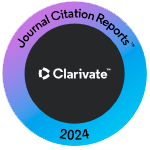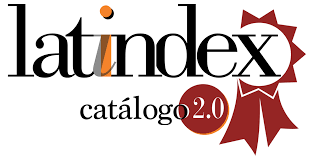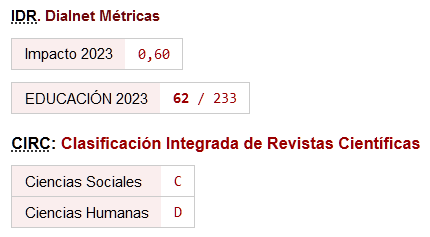Aprendizaje basado en datos y enseñanza de preposiciones en ESL: un estudio de estudiantes árabes
DOI:
https://doi.org/10.46661/ijeri.3809Palabras clave:
Estereotipos de género, Riesgo psicosocial, Lenguajes en la Primera Infancia, Adolescencia, Educación superiorResumen
Este documento explora la efectividad del enfoque de aprendizaje basado en datos en la enseñanza de preposiciones para estudiantes árabes. Se ha informado que las preposiciones en inglés son un rasgo característico que los estudiantes árabes de ESL deben aprender. Además, los estudiantes de nivel intermedio o avanzado también han informado sobre sus dificultades en el uso de preposiciones en inglés; Las razones pueden ser las diferencias perceptivas y culturales entre las dos comunidades lingüísticas. El objetivo del presente estudio fue comparar sustancias formadas por docentes preparadas a partir de recursos en línea junto con el corpus de TPP, para comparar el método de enseñanza de gramática basado en reglas prescriptivas tradicionales y DDL. Dos clases distintas; Se formaron grupos experimentales (n = 41) y de control (n = 19) que estudiaban inglés principal. La prueba estandarizada se realizó como una prueba previa para garantizar a los participantes el mismo nivel de competencia en el uso de preposiciones. Durante la duración del estudio durante un semestre, el grupo experimental fue expuesto a materiales preparados por el profesor junto con TPP para ver las preposiciones en contexto. Además, se les pidió que exploraran más a través de los materiales preparados para reforzar su aprendizaje a partir de los datos. Se administró una prueba posterior al final del curso. Los resultados mostraron que el grupo experimental superó al grupo de control. Se encontró que el rol activo de los estudiantes para dirigir su propio proceso de aprendizaje causó este resultado alentador y una mejor experiencia de aprendizaje para los estudiantes.
Descargas
Citas
Abdul, Z. (1990). An Analytic Study of Errors by Iraqi Students Made in English Prepositions of Place Relation. University of Glasgow.
Al-Khairy, M. H. (2013). English As a Foreign Language Learning Demotivational Factors As Perceived By Saudi Undergraduates. European Scientific Journal, 9(32), 1857–7881.
Alrabai, F. (2014). Motivational Practices in English as a Foreign Language Classes in Saudi Arabia: Teachers Beliefs and Learners Perceptions Fakieh Alrabai. Arab World English Journal, 5(1), 224–246.
Alshammari, A. K. (2015). Developing the English Curriculum in the Kingdom of Saudi Arabia: Possibilities and Challenges, Arab World English Journal (AWEJ), 6(4), 365–372.
Alshammari, M. (2017). Spatial scenes in Arabic and English. Florida International University.
Alshammari, M. (2018a). Experiential Study in Learning English Writing: An Inquiry into Saudi Learners’ Concerns. International Journal of English Linguistics, 8(4), 181–191. http://doi.org/10.5539/ijel.v8n4p181
Alshammari, S. R. (2018b). The Effectiveness of STOP and DARE in Planning and Drafting Argumentative Writing: A case of Saudi College Level Students. Arab World English Journal (AWEJ), 9(1), 350–364. http://doi.org/10.24093/awej/vol9no1.25
• Alshammari, S. R. (2016). The different approaches of teaching writing in the classroom. Language, Individual & Society, 10, 18-24.
Asma, T. (2010). Transfer of Simple Prepositions from Standard Arabic into English : The
Case of Third Year LMD Students of English Language at Mentouri, 2009–2010.
Barabadi, E. and Y. Khajavi. (2017). The effect of data-driven approach to teaching vocabulary on Iranian stuents’ learning of English vocabulary. Cogent Education, 4, 1283876. doi: 10.1080/2331186X.2017.1283876
Bennett, G. (2010). Using corpora in the language learning classroom: Corpus linguistics for teachers. Michigan: University of Michigan Press.
Boulton, A. (2010). ‘Data-driven learning: taking the computer out of the equation’.
Language Learning, 60(3), 534-572.
Boulton, A., & H. Tyne. (2014). Des documents authentiques aux corpus: Démarches pour l’apprentissage des langues. Paris: Didier.
Dornyei, Z. and E. Ushioda. (2011). Teaching and Researching Motivation (second edition). Harlow: Pearson Longman.
Flowerdew, L. (2012). Corpora and language education. Basingstoke: Palgrave Macmillan.
Friginal, E. (2018). Corpus linguistics for English teachers: Tools, online resources, and classroom activities. Abingdon/New York: Rutledge.
Gilquin, G. and S. Granger. (2010). ‘How can data driven learning be used in language teaching?’ in A. O’ Keeffe and M. Mccarthy (eds.). The Routledge Handbook of Corpus Lingusitics. London: Routledge.
Grami, G. M. A. (2010). The Effects of Integrating Peer Feedback into University-Level ESL Writing Curriculum : A Comparative Study in a Saudi Context, Newcastle University School of Education , Communication and Language Sciences.
Guan, X. (2013). A study on the application of data-driven learning in vocabulary teaching and learning in China’s EFL class. Journal of Language Teaching & Research, 4(1), 105- 112. doi:10.4304/jltr.4.1.105-112.
Hasan, A., & Abdullah, I. (2009). A Comparative Study of English and Arabic Use of Prepositions Amongst Arab Native Speakers. Retrieved from: https://www.academia.edu/898700/A_Comparative_Study_of_English_and_Arabic_Use_ of_Prepositions_Amongst_Arab_Native_Speakers
Hashim, H. (1996). English Syntactic Errors by Arabic Speaking Learners: Reviewed, 1424–1462.
Hubbard, P. (2009). Computer-Assisted Language Learning. Routledge: USA.
Johns, T. (1991). Printout to Handout: Grammar and Vocabulary Teaching in the Context of Data-Driven Learning. ELR Journal (Birmingham), 4.
Johns, T. (1991). Chapter 2: Should you be persuaded: Two examples of data-driven learning. Classroom Concordancing. Birmingham: ELR.
Kennedy, C. and T. Miceli. (2001). An evaluation of intermediate students’ approaches to corpus investigation. Language Learning & Teachnology, 5(3), 77-90.
Lin, M. H., and Lee, J. (2015). Data-driven learning: changing the teaching of grammar in EFL classess. ELT Journal, 69(3), 264-274.
Luo, Q. (2016). The effects of data-driven learning activities on EFL learners’ writing development, SpringerPlus, 1255. doi:10.1186/s40064-016-2935-5
Luo, Q. and J. Zhou. (2017). Data-driven learning in second language writing class: a survey of empirical studies, IJET, 12(3), 182-196.
Mishan, F. (2004). Autheticating corpora for language learning: a problem and its resolution. ELT Journal, 58(3), 219-227.
Reppen, R. (2010). Using corpora in the classroom. Cambridge: Cambridge University Press.
Rezaee, A. A., H. Marefat, and A. Saeedakhtar. (2014). Symmetrical and asymmetrical scaffolding of L2 collocations in the context of concordancing. Computer Assisted language Learning, Advance Access Published 3. doi:10.1080/09588221.2014.889712
Schmidt, R. (1990). ‘The role of guided induction in paper-based data driven learning’.
Applied Linguistics, 11(2), 129-158.
Tahaineh, Y. (2014). A Review of EFL Arab Learners’ Language: Pitfalls and Pedagogical Implications. International Journal of English Linguistics, 4(1), 84–102. http://doi.org/10.5539/ijel.v4n1p84
Tahaineh, Y. (2010). Arab EFL university students’ errors in the use of prepositions.
Modern Journal of Applied Linguistics, 1(6), 76–112.
Thomas, J. (2014). Discovering English with the Sketch Engine. In S. Jager, L. Bradley,
E. J. Meima, & S. Thouësny (Eds), CALL Design: Principles and Practice; Proceedings of the 2014 EUROCALL Conference, Groningen: The Netherlands, 363-367. Dublin: Research-publishing.net. doi:10.14705/ rpnet.2014.000246
Thompson-Panos, K., & Thomas-Ruzic, M. (1983). The Least You Should Know About Arabic : Implications for the ESL Writing Instructor. TESOL Quarterly, 17(4), 609–623. http://doi.org/10.2307/3586616
Zahid Javid, C., & Umer, M. (2014). Saudi Efl Learners’ Writing Problems: a Move Towards Solution. The Global Summit on Education GSE 2014, 2014(March), 4–5.
Zhang, Y. and L. Liu. (2014). A corpus – aided approach in EFL instruction: a case study of Chinese EFL learners’ use of the infinitive. English Language Teaching, 7(7), 152-158
Descargas
Publicado
Cómo citar
Número
Sección
Licencia
Derechos de autor 2019 IJERI: International Journal of Educational Research and Innovation

Esta obra está bajo una licencia internacional Creative Commons Atribución-NoComercial-SinDerivadas 4.0.












